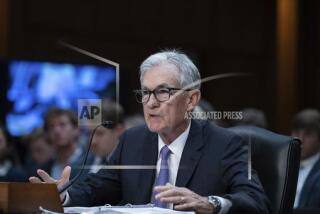IMF lowers U.S. and global economic growth forecasts
- Share via
WASHINGTON — After leading the way out of the global recession, China and other big developing economies now are growing slower, a significant shift in momentum that augers weaker world growth and softer demand for U.S. exporters.
The slowdown in developing economies has been building for some time but has captured greater attention recently because of China’s credit crunch and the prospects of monetary policy tightening by the U.S. Federal Reserve.
On Tuesday, the International Monetary Fund cut its U.S. and global economic forecasts for this year and next, citing primarily slower growth in key developing nations as well as a deepening recession in the Eurozone. The IMF also noted that federal spending reductions in the U.S. were weighing on the recovery.
The world economy will grow 3.1% this year, the Washington-based IMF said, down from its April projection of 3.3%. Growth also will be slower next year — 3.8% compared with an earlier 4% forecast.
The IMF estimated that the U.S. economy would expand at a modest 1.7% rate this year and pick up next year to 2.7%. Both figures also are down 0.2 percentage points from the organization’s projections in its April World Economic Outlook.
Although part of the reason for the change in the U.S. forecast is the automatic federal spending cuts, known as the sequester, the U.S. economy and particularly American export manufacturers are likely to feel a pinch from slower growth in developing and emerging market economies.
For next year, the IMF cut its growth forecast for China by 0.6 percentage points to 7.7%, and it slashed Brazil’s by 0.8 percentage points to 3.2%. The fund also downgraded growth prospects for Russia, India and South Africa, the other three big developing economies that make up the so-called BRICS nations.
Olivier Blanchard, the IMF’s chief economist, said each of these countries had its own set of issues — “In China, it looks like unproductive investment; in Brazil, it looks like low investment; and in India, it looks like policy and administrative uncertainty.”
But he also indicated a common trend: “I think behind this is a slowdown in underlying growth, not the cyclical component but just the average rate.”
Nariman Behravesh, chief economist at economics and markets research firm IHS, agreed. He said countries such as China had boosted growth early in the recovery through strong fiscal stimulus, but failed to take measures to address structural problems in their economies and financial systems.
“They enjoyed the ride, but they didn’t do nearly enough to make their economies dynamic,” Behravesh said, noting that the long period of soft global growth finally brought these problems to the surface.
“On top of that, you’ve got this ‘taper’ panic,” he said of investors’ fears that the Fed will soon start unwinding its easy-money policies, leading to higher interest rates and a flight of capital from emerging economies as investors seek higher returns in the U.S.
In the U.S., the IMF said the sequester’s effect was likely to remain until next year, longer than anticipated in the spring. But as the pace of the spending cuts slows, U.S. economic growth should be able to pick up next year, the IMF said.
And the nation is doing much better than other advanced economies, which as a group are expected to expand just 1.2% this year and 2.1% next year. One factor is that some developed economies, such as Germany, rely more on exports. The U.S. economy is driven mostly by domestic spending.
“Private demand should remain solid, given rising household wealth owing to the housing recovery and still supportive financial conditions,” the IMF said of the U.S. economy.
Even so, the IMF projections for U.S. growth are lower than the Fed’s most recent forecast as well as new White House estimates.
The Office of Management and Budget said Monday that the U.S. economy would grow 2.4% this year and 3.4% next year, though those are down from earlier projections.
The IMF also projected that emerging market and developing economies will expand 5% this year and 5.4% next year, both 0.3 percentage points lower than the April forecast.
As for the troubled Eurozone, the IMF said the region’s economy was likely to contract 0.6% this year before returning to a weak growth of 0.9% next year.
The unemployment rate in the Eurozone was a record 12.1% in May as the single-currency region struggled with its longest-ever recession. The 17-nation zone has had six straight quarters of economic contraction through the first quarter.








